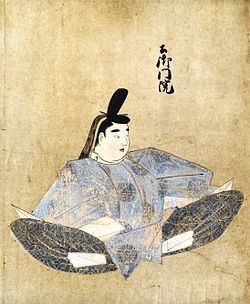Reign 1198–1210 Died November 6, 1231 Predecessor Go-Toba | Parents Minamoto no Ariko Name Emperor Tsuchimikado | |
 | ||
Born January 3, 1196 ( 1196-01-03 ) Burial Kanegahara no misasagi (Kyoto) Children Emperor Go-Saga, Princess Teruko, Sonjo-hosshinno Grandchildren Emperor Kameyama, Prince Munetaka, Emperor Go-Fukakusa Similar People Emperor Jimmu, Princess Shikishi, Kakuei Tanaka, Akihito, Hirohito | ||
Emperor Tsuchimikado (土御門天皇, Tsuchimikado-tennō, January 3, 1196 – November 6, 1231) was the 83rd emperor of Japan, according to the traditional order of succession.
Contents
Tsuchimikado's reign spanned the years from 1198 through 1210.
Genealogy
Before Tsuchimikado's ascension to the Chrysanthemum Throne, his personal name (imina) was Tamehito-shinnō (為仁親王). He was the firstborn son of Emperor Go-Toba. His mother was Ariko (在子) (1171–1257), daughter of Minamoto no Michichika (源通親).
Tsuchimikado's Imperial family lived with him in the Dairi of the Heian Palace. His family included three sons by three different consorts:
Events of Tsuchimikado's life
In 1198, he became emperor upon the abdication of Emperor Go-Toba, who continued to exercise Imperial powers as cloistered emperor.
In Kyōto, Minamoto no Michichika took power as steward, and in Kamakura, in 1199, upon the death of Minamoto no Yoritomo, Hōjō Tokimasa began to rule as Gokenin.
Tsuchimikado removed himself from Kyoto, traveling first to Tosa Province (now known as Kōchi Prefecture); and later, he moved to Awa province (now known as Tokushima Prefecture), where he died in exile.
Tsuchimikado's official Imperial tomb is in Kyoto. The emperor is venerated at a memorial Shinto shrine (misasagi). This mausoleum shrine is formally named Kanegahara no misasagi.
Kugyō
Kugyō (公卿) is a collective term for the very few most powerful men attached to the court of the Emperor of Japan in pre-Meiji eras.
In general, this elite group included only three to four men at a time. These were hereditary courtiers whose experience and background would have brought them to the pinnacle of a life's career. During Tsuchimikado's reign, this apex of the Daijō-kan included:
Eras of Tsuchimikado's reign
The years of Tschuimikado's reign are more specifically identified by more than one era name or nengō.
